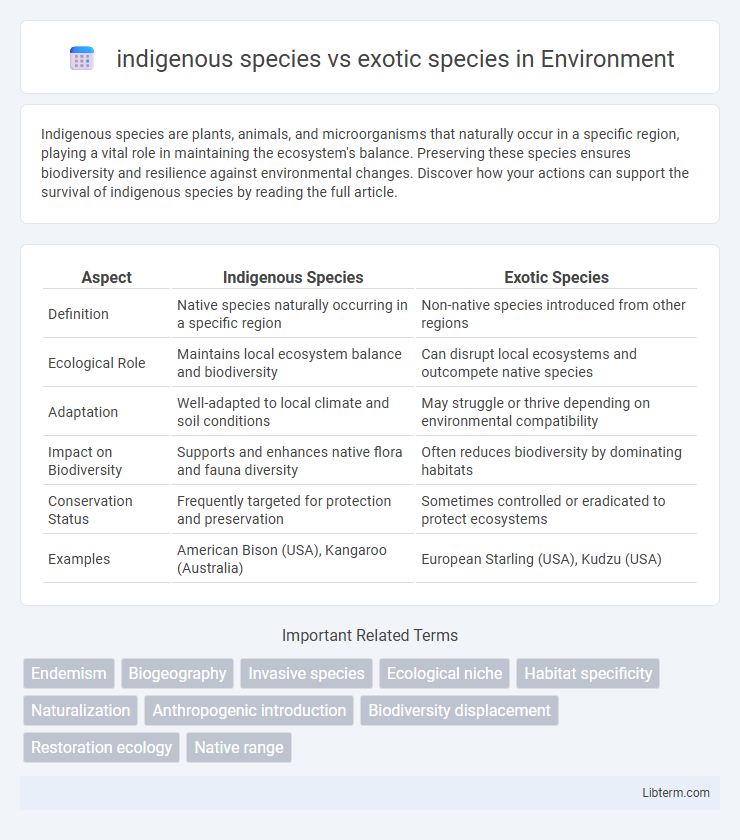Indigenous species are plants, animals, and microorganisms that naturally occur in a specific region, playing a vital role in maintaining the ecosystem's balance. Preserving these species ensures biodiversity and resilience against environmental changes. Discover how your actions can support the survival of indigenous species by reading the full article.
Table of Comparison
| Aspect | Indigenous Species | Exotic Species |
|---|---|---|
| Definition | Native species naturally occurring in a specific region | Non-native species introduced from other regions |
| Ecological Role | Maintains local ecosystem balance and biodiversity | Can disrupt local ecosystems and outcompete native species |
| Adaptation | Well-adapted to local climate and soil conditions | May struggle or thrive depending on environmental compatibility |
| Impact on Biodiversity | Supports and enhances native flora and fauna diversity | Often reduces biodiversity by dominating habitats |
| Conservation Status | Frequently targeted for protection and preservation | Sometimes controlled or eradicated to protect ecosystems |
| Examples | American Bison (USA), Kangaroo (Australia) | European Starling (USA), Kudzu (USA) |
Introduction to Indigenous and Exotic Species
Indigenous species, also known as native species, naturally occur in a specific region or ecosystem, having evolved and adapted to the local environmental conditions over thousands of years. Exotic species, or non-native species, are introduced to new habitats either intentionally or accidentally, often resulting in significant ecological impacts due to their lack of natural predators. Understanding the distinctions between indigenous and exotic species is crucial for biodiversity conservation and ecosystem management.
Defining Indigenous Species
Indigenous species, also known as native species, are organisms that have naturally evolved and exist in a specific geographic region without human introduction. These species have adapted to the local environment over millennia, contributing to the ecological balance and biodiversity of their habitats. Understanding the characteristics and roles of indigenous species is essential for conservation efforts and ecosystem management.
Understanding Exotic Species
Exotic species are non-native organisms introduced intentionally or accidentally into new ecosystems, often through global trade, travel, or human activities. These species can disrupt local biodiversity by competing with indigenous species for resources, altering habitats, and sometimes introducing diseases. Understanding the ecological impacts and pathways of introduction is essential for managing invasive populations and protecting native ecosystems.
Key Differences Between Indigenous and Exotic Species
Indigenous species are organisms native to a specific region, having evolved naturally over time and adapted to local environmental conditions. Exotic species, also known as non-native or invasive species, are introduced to new areas through human activity, often disrupting ecosystems by outcompeting indigenous species for resources. The key differences lie in their origin, ecological roles, and impact on biodiversity, with indigenous species promoting ecosystem stability, while exotic species can lead to ecological imbalance and loss of native biodiversity.
Ecological Roles of Indigenous Species
Indigenous species play critical ecological roles by maintaining ecosystem stability, supporting native food webs, and facilitating nutrient cycling within their habitats. They have evolved in harmony with other local organisms, contributing to soil health, pollination, and natural pest control. The presence of indigenous species enhances biodiversity resilience, ensuring ecosystems can withstand environmental changes and disturbances.
Impacts of Exotic Species on Native Ecosystems
Exotic species often disrupt native ecosystems by competing with indigenous species for resources, leading to reduced biodiversity and altered habitat structures. They can introduce diseases to which native species have no immunity, causing population declines or local extinctions. Invasive exotic species may also modify soil chemistry and hydrology, undermining ecosystem stability and function.
Case Studies: Invasive Exotics vs Indigenous Fauna and Flora
Invasive exotic species, such as the Burmese python in the Florida Everglades, drastically disrupt indigenous fauna by preying on native mammals and birds, leading to population declines and ecosystem imbalance. In Australia, the introduction of the European rabbit has caused extensive habitat degradation, outcompeting native herbivores and altering plant communities. These case studies highlight the critical necessity of managing invasive species to protect biodiversity and preserve the ecological integrity of indigenous flora and fauna.
Conservation Strategies for Indigenous Species
Conservation strategies for indigenous species prioritize habitat preservation, genetic diversity protection, and ecosystem balance restoration to maintain native biodiversity. Efforts often include establishing protected areas, controlling invasive exotic species that threaten native populations, and promoting community involvement in sustainable resource management. Monitoring programs and ecological research are essential to inform adaptive management practices that safeguard indigenous species from extinction.
Managing and Controlling Exotic Species
Effective management of exotic species requires early detection and rapid response strategies to prevent their establishment and spread in native ecosystems. Techniques such as mechanical removal, chemical treatments, and biological control agents are employed to reduce invasive populations while minimizing impacts on indigenous species. Ongoing monitoring and public education play crucial roles in ensuring long-term control and preserving biodiversity.
Future Outlook: Biodiversity and Species Interactions
Indigenous species maintain ecosystem stability by supporting intricate food webs and nutrient cycles, making their preservation critical for future biodiversity. Exotic species often disrupt native habitats, leading to altered species interactions and potential biodiversity loss. Effective management strategies focusing on native species conservation can enhance ecological resilience and promote sustainable coexistence.
indigenous species Infographic

 libterm.com
libterm.com